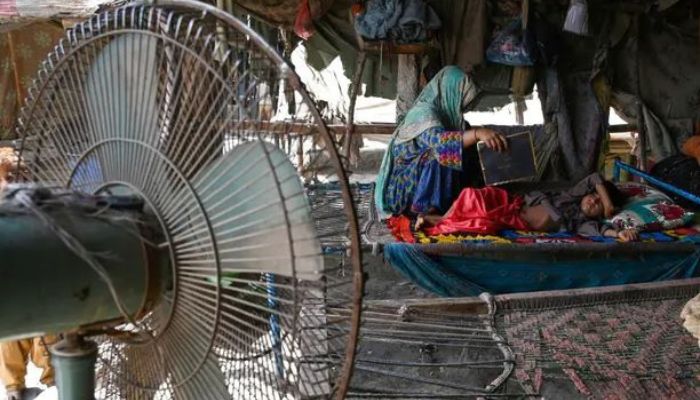Deadly heatwaves every year: Here's what Pakistan must do today
City of Jacobabad in Sindh soared to 50 degrees Celsius – a temperature called unlivable for humans
June 17, 2022

Pakistan is facing record-breaking temperatures and a prolonged heatwave since March this year, leading to a major impact on society, environment, work hours and the economy. The city of Jacobabad in Sindh soared to 50 degrees Celsius – a temperature called unlivable for humans. Pakistan is no stranger to extreme heat which is becoming a new normal, but the current heatwave, with its early beginning, long duration and severity has been worrying scientists.
According to the World Health Organization (WHO), a heatwave is when the maximum temperature exceeds 45C or the deviation from normal temperature is between 4.5C and 6.5C, while severe heatwave is when the maximum temperature exceeds 47C or the deviation from normal temperature is greater than 6.5C.
In the pre-monsoon period, Pakistan regularly experiences excessively high temperatures, especially in May. However, the hot weather started earlier this year in March and April. Weather and climate researchers are now investigating how this heatwave forms. The primary driver behind this heatwave is climate change which has already resulted in a 2C increase in temperature during the months of March-April-May over the last 40 years in Pakistan. Not only this, the previous three months saw a lack of clouds and rainfall, which may have warmed the surface by 5C. The second cause is the fast-moving river of winds in the upper atmosphere, which affects surface pressure and temperature.
In the previous two heatwave episodes, the jetstream formed a ridge/crest, resulting in high pressure and a heat dome over Pakistan. The third reason is that La Nina has been intensifying trade winds and pushing warm water into Asia over the past two years, resulting in warm temperatures throughout the Indian Ocean and the Bay of Bengal, and finally across Pakistan and India.
These extreme weather conditions had been a constant dilemma in Pakistan over the last decade. A study conducted at the Global Change Impact Studies Centre (GCISC) by Dr Shaukat Ali on future heatwaves over Pakistan using Downscaled Global Climate Models projected a high increase in heatwaves. Due to the influence of climate change, future heatwaves are projected to increase in amplitude (severity) up to 48C, duration (length) eight times, frequency (sum of days of all heatwaves) 10 times and number of heatwaves (events) four times.
According to the WHO, climate change has ongoing health consequences and is expected to cause 250,000 deaths per year between 2030 and 2050, with the financial cost of climate-related health impact ranging from $2 billion to $4 billion by 2030. Heatwaves are more than just uncomfortable – they have serious health risks and trigger public health emergencies. They can cause illness and death, especially in sensitive groups such as infants, pregnant women, the elderly, and persons who already struggle with medical issues.
Heatwaves are an extreme climatic event which have become more frequent due to human-influenced climate change and global warming. The impact of excessive temperatures on glacier melt was seen in Gilgit-Baltistan by sweeping away a critical highway bridge in flash flooding, which had a terrible impact on the population as many people lost their houses, fruit orchards, and crops. Extreme temperatures also result in unpredictable monsoon rains. Heatwaves have other multiple and cascading impacts on ecosystems, agriculture, water and energy supplies and key sectors of the economy. Extremely hot and dry conditions have affected agriculture, especially wheat production, sowing of cotton and rice due to less water availability and production of mangoes.
Prolonged exposure to excessive heat had other critical knock-on effects – for example, elevated air temperatures lead to increased demand for air conditioning and, therefore, increased electricity generation by power plants, which further intensifies air pollution problems and greenhouse gas (GHG) emissions.
Extreme weather events, in particular, are a major source of concern in Pakistan, necessitating not only a dedicated research effort on the part of the scientific community, but also effective communication of that research to policymakers in order to develop timely and effective adaptation strategies to minimize future losses. In this regard, a thorough knowledge of future extreme events is necessary to provide policymakers with reliable facts that can influence effective decision-making and infrastructure development.
It is imperative that we protect ourselves by taking adaptive measures. Pakistan has a well-established heat-health early warning systems and action plans. The National Institute of Health (NIH) has issued an advisory for necessary measures and recommendations for educational institutions/schools on actions to mitigate the effect of extreme heat on students, reduce the frequency of heat-related illness, and support schools to prepare for and manage risks associated with extremely hot weather or heatwave. Likewise, the Ministry of National Health Services, Regulations and Coordination (NHSRC) has issued a detailed heatwave advisory for the general public, asking individuals to take immediate necessary measures to protect themselves from extreme heat. Coordinated efforts by the Ministry of Climate Change, Ministry of National Health Services, Ministry of National Food Security and Research, Ministry of Water Resources, Ministry of Information, Ministry of Education, NDMS, PDMAs and DDMAs and municipal governments in tackling the present heatwave are well appreciated.
To improve its resilience to future extreme heat events, Pakistan needs to take strides towards sustainable adaptation and mitigation strategies to tackle the adverse impact of heatwaves. Well-coordinated and effective adaptation strategies need to be put in place by developing heat-tolerant crop varieties and animal breeds. The agriculture sector requires major transformations to build resilience, especially water-use efficiency enhancement.
Death and disabilities from such calamities can be prevented or minimized by sensitization of healthcare departments, climate change and environment protection agencies, agriculture and other infrastructure development authorities. Sufficient collaboration and cooperation among these authorities are necessary to ensure consistency towards healthy society.
Cities can incorporate heat island reduction strategies such as green or cool roofs, cool pavements, or increased vegetation and trees into long-term planning efforts to help lower urban temperatures. Such cooling measures help reduce impacts on public health and urban systems from extreme heat events.
Disseminating public awareness through print, electronic and social media, providing heat-proof shelter facilities during the summer, and easing access to public drinking water would help mitigate heatwave fatalities. Reducing outdoor exercise during heat alerts can protect individuals from the adverse effects of extreme heat.
Pakistan was fortunate that this year's heatwaves were not accompanied by humidity, which could have resulted in a high death toll in the country. Pre-monsoon and monsoon rains are expected to improve conditions, but so far rainfall has been insufficient.
The writers can be reached at [email protected]
Originally published in The News











